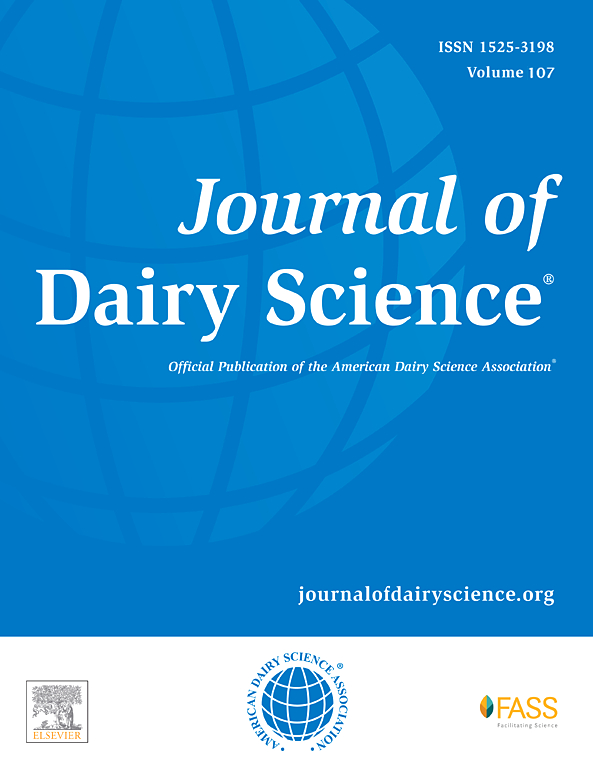Staphylococci and mammaliicocci: Which species are important for udder health on organic dairy farms?
IF 3.7
1区 农林科学
Q1 AGRICULTURE, DAIRY & ANIMAL SCIENCE
引用次数: 0
Abstract
Variation in species distribution and diversity of staphylococci and mammaliicocci (SaM) causing intramammary infections in dairy cattle is associated with different management practices. Disparate selective pressures on organic dairies could potentially result in population differences of these mastitis-causing bacteria. The species-specific effect on quarter SCC of SaM for a population of certified organic dairies has not been described previously. The current study presents data from a longitudinal study of 10 certified organic dairy farms. The objective was to estimate how quarter milk somatic cell count (qmSCC) varied as a result of infection with the most frequently isolated SaM species. Aerobic culture of quarter milk samples to identify IMI was conducted in parallel with determination of qmSCC. A linear hierarchical repeated measures mixed model was used to estimate qmSCC for quarters with an IMI caused by a given SaM species, compared with culture-negative quarters. The model included DIM at time of sampling to adjust qmSCC estimates for each SaM species. The final dataset consisted of 648 quarters with an IMI due to 10 different SaM species and 1,972 culture-negative quarters. Staphylococcus chromogenes was the most frequent species, followed by S. aureus, S. haemolyticus, and S. simulans. A large amount of variability was observed in the SCS for culture-negative quarters and those infected with many SaM species, especially S. chromogenes, S. haemolyticus, S. simulans, and S. aureus. Somatic cell score was significantly higher in quarters infected with S. agnetis, S. aureus, S. chromogenes, S. devriesei, S. haemolyticus, S. hyicus, S. simulans, S. warneri, and S. xylosus compared with culture-negative quarters. The highest cell count was for quarters infected with S. warneri, followed by S. aureus, S. agnetis, and S. hyicus. The relative distribution of various SaM species and their effect on qmSCC in this population of small to midsize organic farms was similar to previous studies. Although the increase in qmSCC was modest for most SaM species observed, the widespread prevalence of these intramammary pathogens could potentially contribute to sizable increases in bulk tank SCC.
葡萄球菌和哺乳动物球菌:哪些物种对有机奶牛场的乳房健康很重要?
引起奶牛乳腺内感染的葡萄球菌和哺乳动物球菌(SaM)的种类分布和多样性的变化与不同的管理方法有关。对有机乳制品不同的选择压力可能会导致这些引起乳腺炎的细菌的种群差异。物种特异性的影响四分之一的体细胞计数SaM为认证的有机乳制品的人口以前没有描述过。目前的研究提供了来自10个认证有机奶牛场的纵向研究数据。目的是估计四分之一乳体细胞计数(qmSCC)如何随着感染最常见的分离SaM物种而变化。对四分之一牛奶样品进行有氧培养以鉴定IMI,同时测定qmSCC。使用线性分层重复测量混合模型来估计由给定SaM物种引起的IMI的季度的qmSCC,与培养阴性的季度相比。该模型包括采样时的牛奶天数,以调整每种SaM物种的qmSCC估计值。最终的数据集包括648个季度的IMI,这是由于10种不同的SaM spp和1972个培养阴性季度。最常见的菌种是嗜铬葡萄球菌,其次是金黄色葡萄球菌、溶血葡萄球菌和拟南葡萄球菌。在培养阴性的区域和感染多种SaM spp的区域,特别是嗜铬葡萄球菌、溶血葡萄球菌、模拟葡萄球菌和金黄色葡萄球菌,在体细胞评分上观察到很大的差异。与培养阴性组相比,感染了agnetis、金黄色葡萄球菌、显色葡萄球菌、devriesei、溶血葡萄球菌、hyicus、S. simulans、S. warneri和xylosus的组的体细胞评分明显更高。感染瓦纳氏葡萄球菌的四分之一细胞数最高,其次是金黄色葡萄球菌、炎性葡萄球菌和hyicus葡萄球菌。在该中小型有机农场群体中,各种SaM种类的相对分布及其对qmSCC的影响与前人的研究结果相似。尽管对于大多数观察到的SaM物种来说,qmSCC的增加幅度不大,但这些乳腺内病原体的广泛流行可能会导致散装罐SCC的大幅增加。
本文章由计算机程序翻译,如有差异,请以英文原文为准。
求助全文
约1分钟内获得全文
求助全文
来源期刊

Journal of Dairy Science
农林科学-奶制品与动物科学
CiteScore
7.90
自引率
17.10%
发文量
784
审稿时长
4.2 months
期刊介绍:
The official journal of the American Dairy Science Association®, Journal of Dairy Science® (JDS) is the leading peer-reviewed general dairy research journal in the world. JDS readers represent education, industry, and government agencies in more than 70 countries with interests in biochemistry, breeding, economics, engineering, environment, food science, genetics, microbiology, nutrition, pathology, physiology, processing, public health, quality assurance, and sanitation.
 求助内容:
求助内容: 应助结果提醒方式:
应助结果提醒方式:


